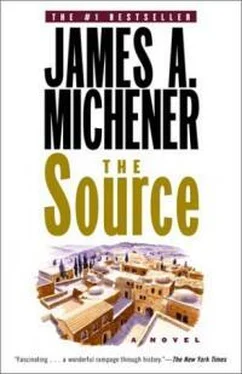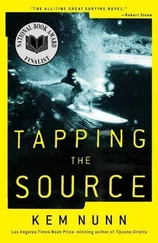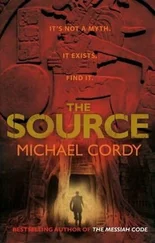Once, sitting in the Akko synagogue on Friday evening, he thought: As a place of worship this is really a dump. The other day I drove to the top of Mount Tabor to attend mass at the Franciscan basilica. It must be one of the most exquisite churches in the world. And now this. I wonder why synagogues are physically so unattractive? Judaism must be the only major religion that doesn’t stress beautiful temples. Perhaps it has something more important … a sense of participating brotherhood, of unity in diversity. On this Friday, as the sun moves across the earth from Fiji where the day begins, to Hawaii where it ends, when sunset comes Jews everywhere will be chanting this same song of welcome … each to his own preferred tune.
The next day as he sat worshiping with the Sephardim in this small synagogue, Cullinane received a strong rebuke which he would not forget during the remaining years at the dig. Jewish congregations did not take public collections the way Christians did; they clung to the very old custom of gathering money to run their synagogues by selling off certain ritual functions: in most synagogues of the mid-twentieth century these contributions were arranged in private, but the Sephardim of Akko—following an ancient tradition—actually conducted a Shabbat auction during holy worship, and it disturbed Cullinane to find the synagogue taken over by a brazen-voiced auctioneer who shouted, “Come now, who will pay fifteen lira for the honor of reading Torah?” And by such public bidding he sold off seven or eight of the holy functions, with the congregation aware of how much each man was willing to pay for his privileges. By some movement of his face Cullinane must have betrayed his disapproval of this profanation of a religious rite, for at the end of the worship the big woman, Shulamit, who had taken him to Elijah’s Cave, came up and asked in English, “Disgusting, wasn’t it?”
“What?” Cullinane asked, trying to appear innocent.
“That auction … in a house of God.”
“Well …”
“It’s almost as bad as the bingo games I used to attend in your churches … in Chicago.” And she threw her big arm about him and they went to an Arab restaurant by the sea, where they got drunk on arrack.
• • •
The first person in Makor whom Father Eusebius met officially was the military commander of the Byzantine garrison, under whose jurisdiction he placed the workmen he had brought with him; in Makor the relationship between church and army would be intimate and Eusebius was determined that it start correctly. He then proceeded to the existing Christian church, a sorry affair at the east of town, where he greeted the uneducated Syrian priest with gentle condescension; he intended no familiarity with this schismatic. And then, because he knew that a large portion of Makor’s population was Jewish, he picked his way carefully through the narrow streets to the groats mill, where he drew his black silk robes about him and stared down at Rabbi Asher, bare-armed and white-bearded as he sweated over sacks of cereal.
The tall Spaniard nodded graciously, half-smiled and said, “I’m told that you’re a scholar, honored by your people.”
Rabbi Asher wiped his forehead and tried to find a seat for his visitor, but the mill was disordered and he could locate nothing suitable. The austere visage of the Spaniard relaxed as he said, “On the boat I sat for many days.”
“Fetch a chair from the synagogue,” Asher directed his foreman, and for the second time the slim visitor noticed Menahem.
“Your son?” he asked as the young man disappeared.
“I wish he were,” Asher said, feeling an instinctive liking for the Spaniard.
“As you know,” Father Eusebius began, “I’ve come to build a basilica.” He hesitated. “A large basilica.”
The acceptance that Rabbi Asher had begun to feel vanished. Why did he have to say a big church? he thought. But Father Eusebius continued, assuring the rabbi that it was his hope not to disrupt Makor but to bring it prosperity. “We shall build rapidly,” he explained, “and will import no more soldiers than we already have.” He paused. “I shall hope that you will instruct your Jews …” He left the sentence unfinished, Nodding graciously he left just as Menahem ran up with the chair. “We shall save that for another day,” he said charmingly as he went off to inspect the town which would occupy him in the years ahead.
The Makor to which Father Eusebius had come to build his basilica looked far different from the way it had in its days of beauty under King Herod, and almost nothing that the meticulous Spaniard saw could have reminded him of the Greek charm that had once invested this place. The walls were down, so that the settlement lacked any external unity houses now perched precariously on the steep slopes and were propped up by timbers that gave the impression of a village hanging out its wooden washing. The lovely forum was gone; not a temple stood nor even the walls of a temple. The residential palace had long since been torn apart for building stone, and here and there throughout the town one could find the base upon which the statue of an emperor had once stood, now perched on end to form part of a kitchen wall. The gymnasium was gone: where were the statues of naked Epiphanes posing as a discus thrower or of fleet Hermes the runner?
Even the two components that had best characterized Makor were vanished: the well was forgotten and the David Tunnel was no longer used. Its deep shaft was almost completely filled in, for during the past three hundred years it had served as the town dump. Now women of the town walked down a steep flight of wooden stairs that descended into the wadi, where a completely new well had been dug; Makor did not even remember the sweet source from which the town had taken its name.
Father Eusebius, accustomed to the grandeur of Rome and Constantinople, did however find one structure with a kind of peasant charm, a building he could respect. It was the synagogue standing near the middle of town, and as he came upon it this first day he stopped at the southern end to study the heavy, stately façade shaped like that of a Greek temple but lacking the perfection that marked all true Greek architecture. The portico was supported on six rather ugly stone columns, and Eusebius remarked to his architect: “Whoever carved those pillars was no Greek.” But he had to grant that the effect was strong. Under the portico stood three doors topped by carved lintels, and the excellence of the western one showing grape clusters, date palms and a small wagon, intended no doubt to represent the holy ark, impressed the Spaniard and he stepped reverently upon the porch to peer inside; and there for the first time he caught a sense of Palestinian grandeur equal in its rough way to the fine things being built in Constantinople, for the interior ceiling was supported by eight columns of perfect proportion, differing in color and obviously stolen from some Greek or Roman building, for no Jew could have carved such pillars. They gave the synagogue a poetic beauty, but what impressed Eusebius more was the mosaic floor, in which he saw before him composed in cubes of local rock the design of Galilee: birds resting on an olive tree, sly foxes waiting in the rushes, and formalized little streams running down from purple mountains, a gathering of diverse elements into an artistic unity.
“Demetrius!” he called. “Look at this.”
A Byzantine assistant came to inspect the mosaic and was impressed, for it was finer than his workmen were able to produce. “Who did it?” Demetrius asked.
“They must have imported someone from Byzantium,” a workman in mosaic suggested.
Eusebius went back onto the portico and asked in Greek of a passing Jew, “Who built your floor?” The man did not understand, but Menahem, returning the chair to the synagogue, moved forward to say, “My father made it.”
Читать дальше








![Джеймс Купер - Пионеры, или У истоков Саскуиханны [The Pioneers, or The sources of the Susquehannah]](/books/395797/dzhejms-kuper-pionery-ili-u-istokov-saskuihanny-t-thumb.webp)

